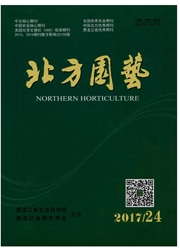

 中文摘要:
中文摘要:
以山西灵丘苦荞壳干燥粉末为试材,利用微波辅助提取技术对苦荞壳总黄酮的提取工艺进行研究,在单因素试验的基础上,选择不同乙醇浓度、时间、液固比、功率4因素,通过BoxBehnken中心组合设计试验和响应面分析法,模拟得到二次多项式回归方程的预测模型;并以叔丁基对苯二酚为对照品,采用DPPH法研究不同方法苦荞壳黄酮提取物对自由基的清除作用。结果表明:苦荞壳总黄酮的最佳微波提取工艺为:乙醇浓度57.54%、微波时间41.09s、液固比65.4∶1mL/g、微波功率264.16W,总黄酮得率实测值为1.9800%,预测值为2.004%;苦荞壳黄酮提取物具有较强的抗氧化作用,不同方法提取液在对DPPH的清除率为50%时,苦荞壳黄酮浓度为0.96μg/mL(超声波法)、1.40μg/mL(微波法)、1.27μg/mL(索氏法),而叔丁基对苯二酚的浓度为2.40μg/mL(CK),试验表明苦荞壳黄酮是一种很有前途的天然抗氧化剂。
 英文摘要:
英文摘要:
Taking dry powder of tatary buckwheat shell from Lingqiu of Shanxi as malerial,the total flavonoids of tatary buckwheat shell was studied with the microwave-assisted extraction technology. The quadratic polynomial regression equation prediction model was obtained by using the Box-Behnken central composite test and response surface analysis based on tile single factor experiments, such as different alcohol concentration (A), time (B), liquid-solid ratio (C), and the microwave power(D). The free radical scavenging rates of the flavonoids of tatary buckwheat shell using DPPH was tested with tert-butyl hydroquinone as the contrast. The results showed that the optimal conditions of microwave-assisted extraction of the total flavonoids were as follows:57. 54% of solvent concentration,time of 41.09 s,65. 4 : 1 mL/g of the ratio of liquid to sotid, power of 264. 16 W, the yield of total flavonoids was up to 1. 9800G, the predictive was of 2. 004~//oo. The flavonoids of tatary buckwheat shell had a strong antioxidant effect, the scavenging rates of tatary buckwheat shell flavonoids was up to 50% to DPPH,C50% of tatary buckwheat shell flavonoids were at 0. 96μg/mL with ultrasonic method, 1.40 μg/mL with microwave- assisted extraction, 1.27 μg/mL with soxhlet extraction, and 2. 40 μg/mL of the tert-butyl hydroquinone(CK), respectively. The tatary buckwheat shell flavonoids was a promising natural antioxidant.
 同期刊论文项目
同期刊论文项目
 同项目期刊论文
同项目期刊论文
 期刊信息
期刊信息
